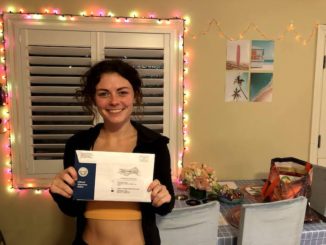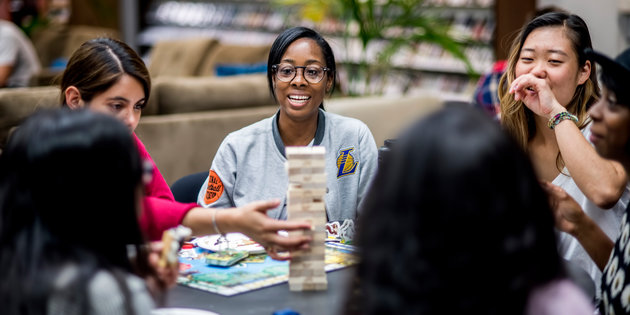
Imagine your heart beating out of your chest. Shaking hands. Quickened breath. A knot of nerves and excitement in your stomach. You’ve trained for months, with no shortage of sweat and exhaustion. Game day arrives, and the stands are only half-filled with supportive students.
On Pepperdine’s athletic fields and courts, college athletes bring high amounts of energy to each game they play. At the average sporting event, the student seating section is less than half full.
Student athlete Rachel Wilt, who is on the Pepperdine swim team, said she feels disheartened by the lack of attendance.
“It’s disappointing to see the stands so empty,” Wilt said. “We work our butts off, but no one shows up for the swim meets.”
However, Pepperdine has seen a 144 percent increase in student attendance at athletic games since last school year, Riptide coordinator J.J. Breihl said. Breihl believes this is due to Pepperdine’s outstanding athletes and their success in this year’s season.
The biggest challenge that Riptide faces is getting fans to go to games. Based on a poll taken with students last year, many of them only want to go to games if their friends are going. This forces Breihl and his team to ask “how do we get the person to your right to go to the game?”
“We want to see the team all the way through, especially since they’ve had a good season,” Breihl said. “They’ve had a lot of growth; Coach Martin Wilson (of the men’s basketball team) says they are on the rise.”
Pepperdine’s men’s basketball team is one of the most popular revenue-generating sports on campus, along with men’s volleyball.
“They’re a young (basketball) team; there’s no seniors,” Breihl said. “There are a lot of little success stories that we’re seeing from them. We’d like to see more of that in terms of attendance.”
Breihl described how frustrating and disheartening it is for the athletes, especially since the athletics teams support each other so strongly. Since the athletics community is so large, when you’re supporting teams, you’re supporting friends and classmates.
“To say that students don’t have an impact on the game would be a total lie in my opinion. We want to control the environment, and it does change the game,” Breihl said. “The energy of the players and spectators can really get into the opponent’s head, and it really changes Firestone Fieldhouse into an electric environment.”
Sophomore student-athlete Jon Lawlor voiced his opinions on the lack of student attendance.
“I just don’t think students know how successful we are as a program. They don’t know how many NCAAP championships we have compared to other schools,” Lawlor said. “School spirit could use a little boost. It’s fine as-is, but it’s not terrible.”
According to Pepperdine’s website, Pepperdine has 17 Division I teams with nine NCAA championships, 23 national champions, 48 Olympians, 190 conference titles and 281 All-Americans.
Lawlor, as a cross-country runner, also talked about what it’s like to be a student who is engaged in a less prominent sport at Pepperdine.
“I believe that Pepperdine values academics more so than athletics, and that sometimes they fail to accommodate the student-athletes’ needs financially, physically and so on,” Lawlor said.
He said the Pepperdine Athletics administration seems to focus more on generating revenue and can occasionally lose sight of the individual student-athlete. However, Lawlor praises the coaches and trainers.
“My trainer Adam is super involved; if every admin worker were like Adam, it’d be amazing,” Lawlor said. “I mean, there are a lot of people in the Athletics department who are exceedingly helpful with anything that I need, but my main problem is with the administration.”
Lawlor later stated that it felt disheartening for some of the athletes to be treated differently from those who play the “revenue-generating” sports. As far as student support for athletics, Lawlor said that he understood where students were coming from when they were unable to attend events.
“I think people are so busy with other things, people usually have weekend trips and I don’t blame them,” Lawlor said.
Breihl also touched on the competition that Riptide faces when trying to grab students’ attention on campus.
“It’s hard to compete. Everything is free, and there’s always some incentive. There’s only so much we can do with our limited budget,” Breihl said. “Other universities, they don’t have to do that. Students are lining up outside of doors and paying to see games.”
Breihl said one of the main objectives of Riptide is to create buzz on campus. Whether it is free T-shirts and food at the games, Breihl and his team are constantly thinking of new, innovative ways for students to want to see games. But it can’t just be about incentives, Breihl added.
“It’s something we tell the players and staff: ‘Give a student a reason to be there and a good experience so they want to go back and be there the next time,’” Breihl said. “We try to do little things that try to keep them for the entire game.”
Associate Director of Marketing for Athletics Karina Herold said student attendance has risen quite dramatically this year, and they’re very proud of that. Last year Pepperdine’s non-break student attendance average was 288, and this year the average is 414. In terms of quantifiable data, the administration and Riptide team are very pleased.
One of the largest challenges that Riptide tackles is getting the teams and students involved by creating an environment on campus where students are engaged.
“We’re trying to build little teachable moments for our fans and teams,” Breihl said. “It’s less about what the score says on the scoreboard and more about what’s going on in the stands. It gives people the chance to come back.”
Breihl said he would love to see more support from the university, since a strong support for the athletics community on campus could benefit the university’s publicity, prospective students and donor engagement.
“I just think it’s a positive impact on the entire campus,” Breihl said. “When there’s a little more buzz on campus about the next game, it makes this campus more fun to be on.”
Gracelyn Sweeney completed this story in Professor Wendy Fontaine’s fall 2014 Jour 241 class.



